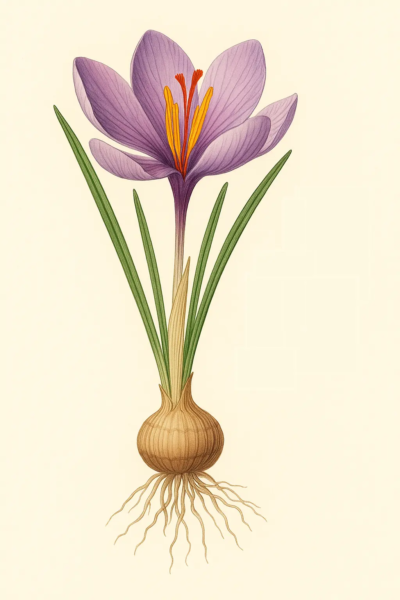Anatomy of Saffron
Saffron comes from the flower of the domesticated Crocus sativus. This plant never grows in the wild. Farmers created it by selecting wild crocus plants for their long stigmas. Over generations, this led to a cultivated flower prized for its saffron threads.
Root and Corm Structure
Saffron grows from a bulb-like organ called a corm. Each corm stores starch underground. Farmers dig them up yearly. Then they divide the corms and replant the pieces. A single corm can produce up to 10 new “cormlets” each season.
These corms measure up to 5 cm across. They have a flat base covered in thin, parallel fibrous layers called the corm tunic. Thin net-like fibers also emerge above the bulb’s neck and help protect the plant.
Leaves and Growth Cycle
The plant grows to about 20–30 cm tall. It produces 5–11 protective sheath leaves, called cataphylls. These cover the developing green foliage. Saffron then unfolds 5–11 narrow green leaves, 1–3 mm wide.
Sometimes the cataphylls appear before flowering. In spring, the plant sends out its full green leaves, each reaching up to 40 cm in length.
Flower Anatomy
Each autumn, saffron blooms with purple flowers. These flowers appear in October, after most garden plants finish flowering. The bloom colors range from pale lilac to deep mauve. You can smell a sweet, honey-like fragrance.
Each flower grows a three‑pronged style. At the tip of each prong, you’ll find a vivid crimson stigma. These stigmas measure 25–30 mm long and are the source of saffron threads.
Reproductive Traits
Crocus sativus is a triploid plant. It has three sets of chromosomes (3 × 8 = 24 total). This makes it sterile from a seed-production standpoint.
The plant reproduces only through corm propagation. It relies entirely on human cultivation. Each year, farmers break apart the corms and replant them to grow new crocus plants.
Key Chemical Components
Saffron threads contain compounds that give color, flavor, and aroma. Crocin gives them a golden-yellow hue. Picrocrocin delivers a slightly bitter taste. Safranal creates the warm, hay-like fragrance.
Want to learn more about saffron cultivation or quality? get in touch for orders.




Get Social